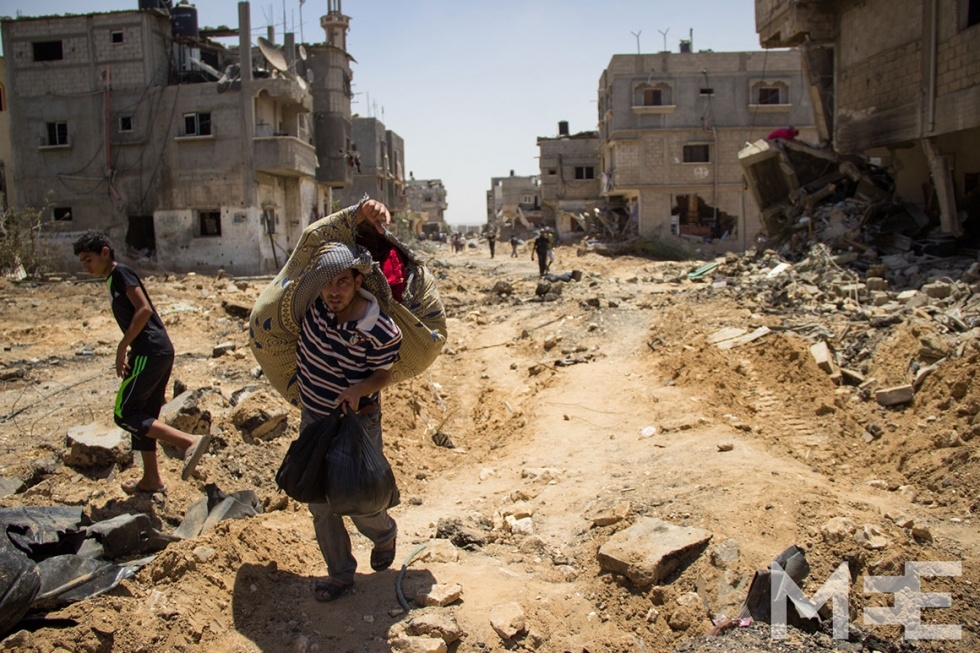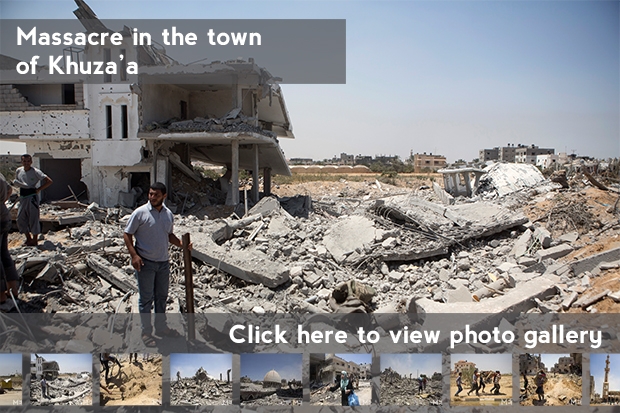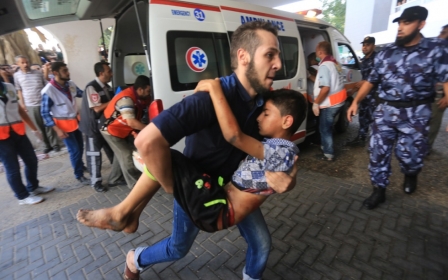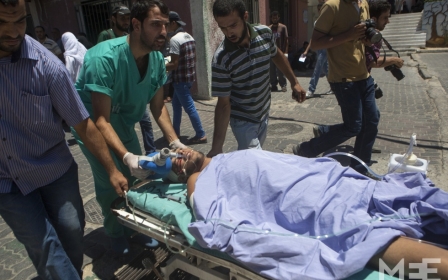In pictures: Ceasefire not long enough for residents of Khuza’a

Gaza Strip, Khuza'a - Rasha an-Najjar with her sister and another relative rushed through the rubble, combing through what used to be a main road of Khuza'a village. Rasha, a 28 year-old mother of four, and five-months pregnant, climbing mounts of sand and rubble that blocked the way, in the noon heat, in plastic sandals, with sweat running down her face, could barely keep up with the other two women. Like hundreds of others, she was rushing to her house while Israeli tank shelling sounded nearby, to recover an additional change of clothing for her children. A 72 hour-long ceasefire was supposed to start Saturday morning, announced earlier by American Secretary of State John Kerry, but in the end, it only lasted two hours.
Rasha passed a broken arch that used to greet Khuza'a visitors in French and Arabic, she left behind the ambulances that arrived at the entrance to the village. The damage done to the road did not allow them to go further in. Private cars, as well as carts pulled by donkeys, were continously bringing out bodies the people of Khuza'a managed to pull out of the rubble.
According to doctor Bashar Murrad, the head of emergency medical services at the Palestinian Red Crescent, only today 47 bodies were brought to the main hospital in the area, Nasser hospital from Khuza'a and Khan Younis. We still don't know how many people were killed in Khuza'a. We don't have enough bulldozers to get to all those people buried under the rubble, but the smell of decomposing bodies indicates there are more,” he told Middle East Eye.
Rasha and her sister Ahlam walked by the ruin of homes, entire segments of the village completely flattened, not even a tree standing. Climbing the mount of sound, a side of a crater created by a bomb, Rasha and her sister didn't slow down when they passed a group of men trying to pull out a body from under the collapsed walls of a mosque. Only the dome on the top indicated what the structure was before. They tried not to look at the destruction around, fearing what would be left of her house. As they arrived at their four-story home, they breathed a sigh of relief. Although damaged, the house was still standing. But the entrance now led through a hole in the wall, probably made by a tank shell.
The ground floor belonged to the patriarch of the family, 65 year-old Suliman an-Najjar, Rasha's father-in-law. ‘He was killed, and only today we recovered his body. The men went to bury him, so we came to grab the most necessary items,” she told the Middle East Eye.
Frantically packing baby clothes and medicines, she could not even recall which day all of it happened. ‘The first night of fighting, but I don't know anymore how long ago that was. The fighters told us not to leave the houses. The shelling of the area was intense. Then the Israeli army came to our house, they arrested my husband, and his father Hajj Suliman - may his soul rest in peace - and others from the adjacent buildings, maybe 30 people. We were told to leave immediately, with white flags and hands up,” she added.
Some of those arrested were later released at the northern border crossing with Israel, Erez, and others at the edge of the village. ‘Some of the men told us that Hajj Suliman was released in the village, and as he walked back, towards Khuza'a, he was killed” Rasha said.
Khuza'a came under heavy shelling on Monday night, 21 July. Israeli army ordered all the inhabitants of the village, nearly 10,000 people to leave, but a third decided to stay, hoping the bombing and the clashes with the Palestinian fighters in the village would be over soon. But after a horrific night, almost everyone tried to evacuate the next day. The witnesses described what they saw as a massacre, with bodies scattered in the streets. Khuza'a remined a closed military zone, and only the International Committe of the Red Cross managed to secure a few brief incursions into the village to evacuate some of the injured, killed and the civilians.
When Rasha climbed another floor, entering her family apartment, she found Hebrew writing on the bedroom walls of her children indicating the directions: north, south, east, west, there was a small booklet in Hebrew, a bottle with a lable with face of a rabbi glued to it and other military items left behind by the soldiers who occupied, and often trashed the houses in Khuza'a. Other people found Israeli cigarettes, a special army edition it seemed, as the pack was in camouflage colours.
As Rasha searched for the documents in the house, people started screaming in the street, the Israeli army shot flares nearby and tank shelling sounded closer by the minute. Rasha got out with two plastic bags, a pillow case stuffed with children's’ clothes, her son’s medicine for epilepsy and started heading back.
Her sister, 30-year-old Ahlam, stayed a little while longer inside the building, looking for diabetes medications for their father. A few minutes later she caught up, and the women discussed what they managed to get out of the house. Rasha grabbed two passports, but she couldn't find other documents. ‘What about the oil? The flour?” asked Ahlam. Rasha shook her head, there was not enough time, nor enough hands to grab everything.
On the way, someone, probably a relative, gave them a half-empty canister of fuel. They walked until they reached a huge hole in the ground, partially blocking the road. On the other side of the hole, a man with a cart and a donkey took them back to Khan Younis, where their family found shelter in their relatives home.
As they drove away, people started rushing around even more as the news of a kidnapped Israeli soldier reached Khuza'a. There is no ceasefire, go, go,” people told each other. The roads were full of Palestinians walking in long lines with a few of their possessions, away from the eastern borders. People carrying bundles of things, were leaving all the eastern areas and flooding the main north-south road, Salahaddin, apparently fearing that the ground invasion would expand.
Middle East Eye propose une couverture et une analyse indépendantes et incomparables du Moyen-Orient, de l’Afrique du Nord et d’autres régions du monde. Pour en savoir plus sur la reprise de ce contenu et les frais qui s’appliquent, veuillez remplir ce formulaire [en anglais]. Pour en savoir plus sur MEE, cliquez ici [en anglais].





